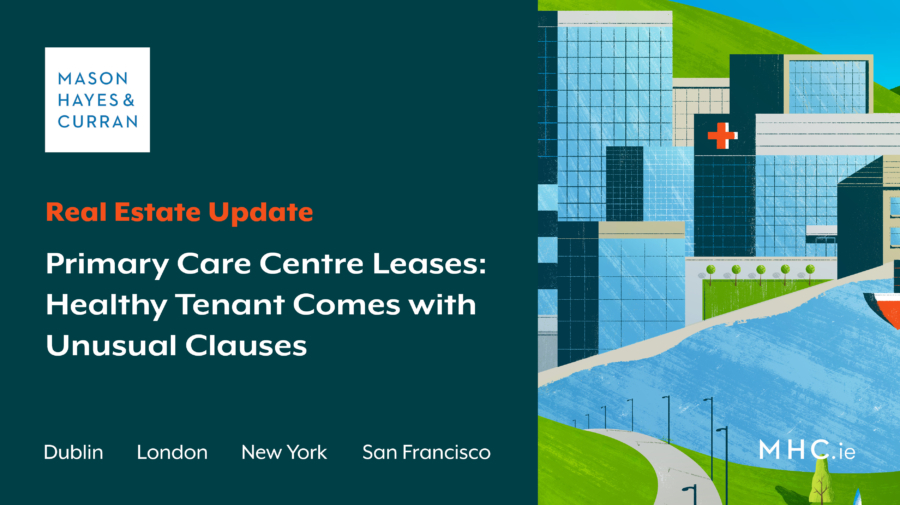
Budget 2023 committed the Irish Government to its highest ever spending on the health sector at €23.4 billion. Improved healthcare services and facilities are at the top of the Government’s and the electorate's agenda with the delivery of primary care integral to the Sláintecare strategy. The Health Service Executive (HSE) is aiming to deliver nine new primary care centres this year through its 2023 Capital Plan. The rapid rollout of these centres has been facilitated through the HSE entering into an operational lease arrangement with landowners. We discuss some key considerations around these HSE primary care centre leases and how they differ from a market standard commercial lease.
What are primary care centres?
Primary care comprises all of the health or social care services that you find in the community, outside of a hospital campus. These include general practitioner (GP) clinics, physiotherapists, ambulance rapid deployment points, community mental health and Tusla (child protection and welfare) services. The Government's core objective for primary care is to deliver care directly into the community, thereby, reducing hospital waiting lists and waiting times. Each centre supports around 7,000 – 10,000 people. The centres are purpose built and offer an alternative to hospitals for conditions that require preventative care and ongoing management. Some 18 new primary care centres opened in 2022, bringing the total number of operational centres to 165.
Unusual clauses
The legal framework of primary care centres is typically structured on the basis of an operational lease granted to the HSE, as tenant, by the developer/owner of the centre. The standard terms found in HSE primary care leases are generally more favourable to the tenant than the market standard for commercial leases, which should be borne in mind by any prospective landlord. Each lease will be negotiated with the HSE on a case-by-case basis but some norms have developed. Some of the key clauses to look out for in HSE primary care centre leases are:
Repair and maintenance
The HSE will not be liable for repair or maintenance. This is very unusual for commercial leases generally. The HSE’s obligations are, in this respect, very limited – not to “deliberately or recklessly damage” the property. A separate Service Level Agreement (SLA) is often entered into under which repair and maintenance services are carried out by the landlord and funded by the service charge paid by the HSE. These SLAs make provision for more stringent repair, maintenance and health and safety obligations on the part of the landlord than would be found in a regular lease to ensure the high operating standards of primary care centres are met and maintained.
Yield up
The HSE will typically be obliged to hand back the leased premises in the state of repair and condition that exists at the date of expiry of the term. The HSE will not be liable for fair wear and tear including for any damage and disrepair due to its normal activities over the passage of time, which would be unusual for a newly-built building.
Alienation
Given the attractiveness of the HSE as a tenant due to covenant strength, a Landlord will be anxious to ensure that the HSE remains as tenant.
Generally, as is the market standard, the HSE in seeking consent to any proposed alienation, e.g. assignment to a third party or sub-letting, must apply to the landlord and provide all reasonable information concerning the change in tenant/occupier as the landlord may reasonably require. A landlord cannot unreasonably withhold its consent to alienation generally pursuant to landlord and tenant legislation.
The HSE primary care centre leases often allow the HSE, as tenant, to enjoy more tenant-friendly alienation rights. These can include the entitlement to:
- Sub-let at less than the passing rent,
- Grant rent-free periods, and
- Alienate part of the property.
Significantly, the landlord may not be entitled to withhold consent to an assignment or sub-letting by the HSE to a party which will “assume responsibility for primary healthcare”.
Termination
In primary care centre leases, it would be common for the HSE to have the ability to terminate the lease where a minimum number of GP tenants are not maintained by the landlord. This termination right is sometimes limited to the first five years of the term.
Conclusion
The expansion and delivery of the HSE’s primary care plan will see many more primary care centres around the country. The attractiveness of these leases is contingent on the HSE being a secure tenant over the term of the lease. Investors, lenders and landlords need to be aware that the HSE form of lease is not a standard commercial lease and contains some important terms and conditions that favour the HSE. Prospective landlords and investors should be mindful of the additional obligations and tenant rights that come with primary care centre leases relative to the market standard – in particular, that:
- Repair and yield up provisions should be carefully reviewed to understand the landlord’s repair obligations during the term and additional expenses at termination.
- The location of the primary care centre as it relates to the number of GPs in the area should be borne in mind in light of minimum GP requirements.
- Landlords should be mindful of the more tenant friendly alienation provisions in the event of a proposed assignment or sub-letting of the property.
For further information, please contact a member of our Real Estate team.
The content of this article is provided for information purposes only and does not constitute legal or other advice.
Share this:


